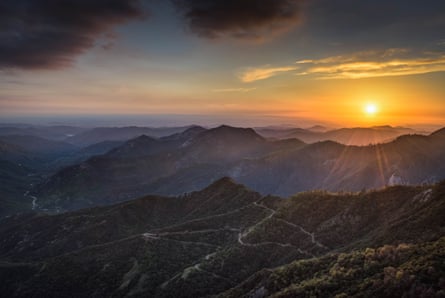One-hundred-eleven years and a few months ago, Theodore Roosevelt signed the landmark law that helped cement his place as America’s conservation president.
The Antiquities Act is brief – just two sentences allow a president to set aside for federal protection “objects of historic or scientific interest”.
It’s been used dozens of times by 16 presidents from both parties to preserve some of America’s most beloved wild lands and historic landmarks, laying the foundations for national parks and generations of family adventures. Many national parks – including South Dakota’s Badlands, Alaska’s Kenai Fjords and Death Valley in California and Nevada – began as national monuments.
Those lands are now facing a two-headed assault from Congress and the Trump administration, and the act itself faces an uncertain future.
Within a few months of signing the Antiquities Act, Roosevelt chose the country’s first national monument – a hulking 1,267ft-tall butte that towers above the forests of eastern Wyoming. In his proclamation on 24 September 1906, Roosevelt called Devil’s Tower “such an extraordinary example of the effect of erosion in the higher mountains as to be a natural wonder”.
‘There’s nothing like it in the world. Protecting it was crucial’

Jeff Muratore, an avid outdoorsman from Casper, Wyoming, hunts in the shadow of Devil’s Tower.
“Growing up in Wyoming and hunting the Black Hills, it’s familiar from many of the mountains around,” he says. “I think it’s important that it’s been protected because of how unique it is. There’s nothing like it in the world. Protecting it was crucial.”
If a bill quietly working its way through the House of Representatives right now were law 111 years ago, Devil’s Tower wouldn’t have qualified as a national monument. Neither would the Grand Canyon, which Roosevelt protected as a monument in 1908 before it was made a national park. Nor would the Petrified Forest national park, Utah’s Zion national park, Bryce Canyon or many of America’s other legendary protected lands.
For Greg Munther, a retired forest ranger and biologist in Missoula, Montana, the national landmark closest to his heart is a the Upper Missouri River Breaks, a nearly 500,000-acre stretch of wild and scenic river in north-central Montana.
Munther first visited the spot about 40 years ago and was awestruck. “It was just mind-blowing,” he said.
“You don’t see intrusions, you don’t see modern life. When you are in there and you think about the history, and it’s still intact. It’s just like it was when Lewis and Clark took their boats up.”
The Upper Missouri River Breaks wouldn’t qualify as a monument under the bill, sponsored by Republican Rob Bishop of Utah. Like many monuments, it’s too big. The measure would cap the size of monuments and, critically, remove the ability to protect monuments of scientific interest, ruling out places selected for their unique formations like the giant sequoia trees of California and Wyoming’s Fossil Butte.
In an op-ed in the Washington Examiner, Bishop called the Antiquities Act, “a menace to constitutional government”. Bishop targeted Barack Obama’s use of the act to protect 553.6m acres in two dozen monuments across the country. “Actions such as these are not the rule of law,” he said. “It is arbitrary rule by one man.”

Bishop’s bill, which has drawn united opposition from sporting and recreation groups across the country, could give legal authority to the Trump administration to shrink monuments. The interior secretary, Ryan Zinke, this summer recommended reducing the size of Bears Ears and Grand Staircase-Escalante in Utah, and Oregon’s Cascade-Siskiyou monument, but he hasn’t made his review public.
Public lands supporters across the American west see it as hand-in-glove with the Trump administration’s efforts to shrink public lands and protections. For many, the attack is personal.
“You look at places like the Upper Missouri Breaks here in Montana or the Organ Mountain Desert Peaks in New Mexico, these monuments are places for us to go experience the solitude and challenge that really only our public lands allow us,” said Land Tawney, president of Backcountry Hunters and Anglers, a national conservation group based in Montana. “Our connections are deep and pretty strong. These are not places you put on a shelf.”
Bishop’s office did not respond to requests for comment on the measure, which last week passed the House natural resources committee without public hearing.
Three million comments left by the American public
For a sense of the depth of America’s love affair with its national monuments, take a stroll through the nearly three million comments submitted to the interior department on Zinke’s still officially private review of the scope of national monuments.

The vast majority – one appraisal says 96% – favor keeping current monuments for future generations. Zinke has dismissed the flood of comments, saying they were part of a “well-orchestrated national campaign”. And yes, many are repetitive; many are personal.
One person wrote:
“I grew up in Arizona, traveling to national monuments with my family on vacation in a pop-up trailer. Camping around the country to go visit national monuments was a highlight of my childhood and one I would like my future children, grandchildren and great-grandchildren to experience.”
Others go straight to the point:
“Please do not reduce our public monuments. They are more important than most people understand. They should be expanded, not reduced.”
And another:
“I want public lands preserved so my daughter and her children can enjoy the natural beauties of America as I was able to do growing up.”
Zinke’s monument review reportedly includes a surprising expansion – a recommendation for a new monument in his home state of Montana, protecting the Badger Two Medicine, a wilderness sacred to the Blackfeet Indian Tribe.
But there’s a catch, even for the swaggering interior secretary who styles himself as a modern-day Theodore Roosevelt.
At nearly 130,000 acres, his favored wilderness is too big, and too wild, to qualify as a monument under Bishop’s bill.
